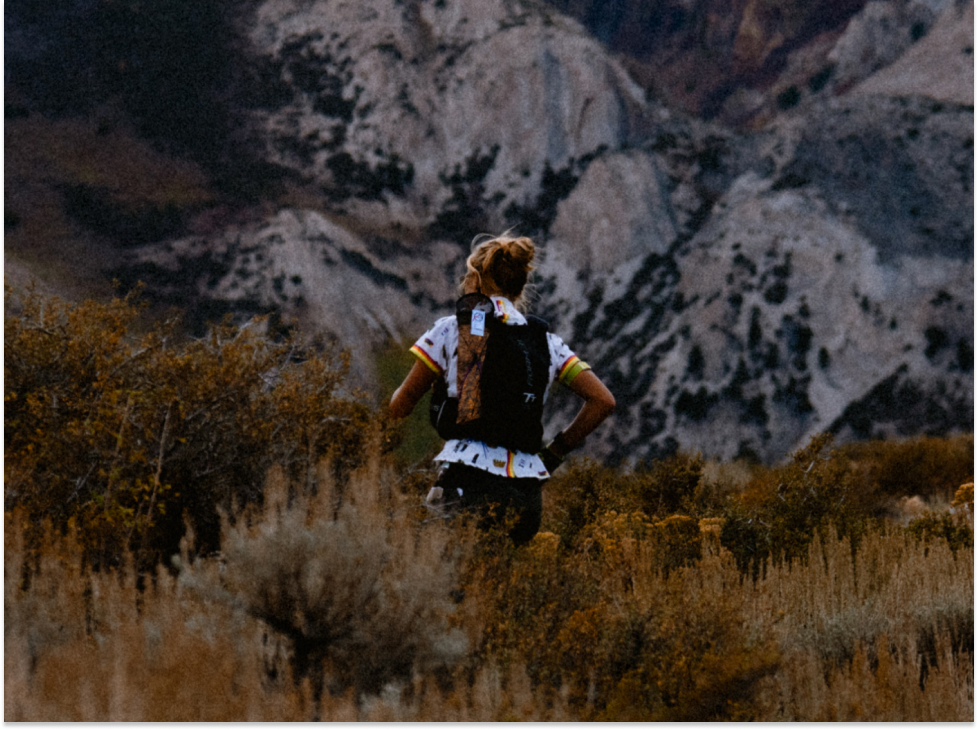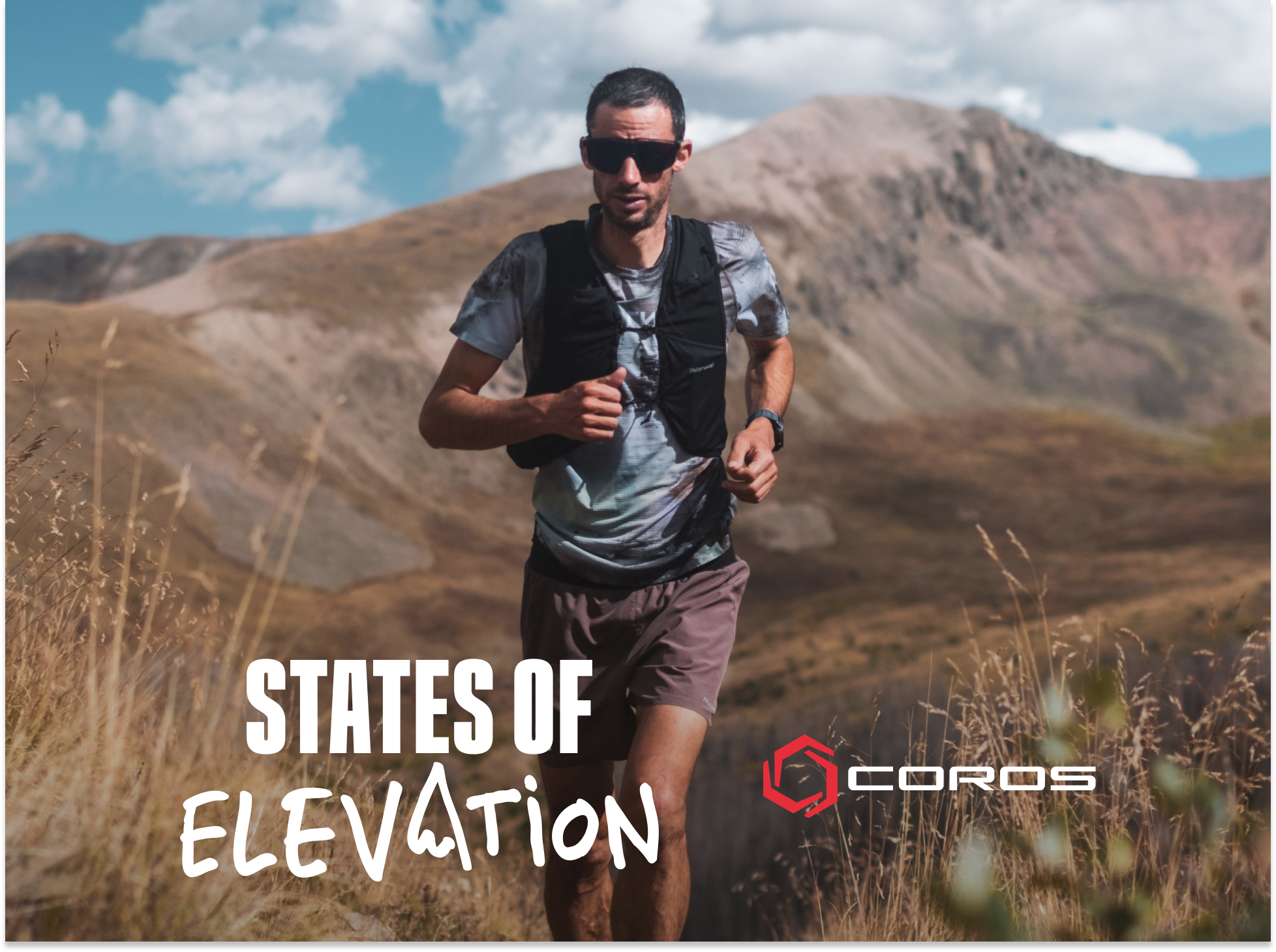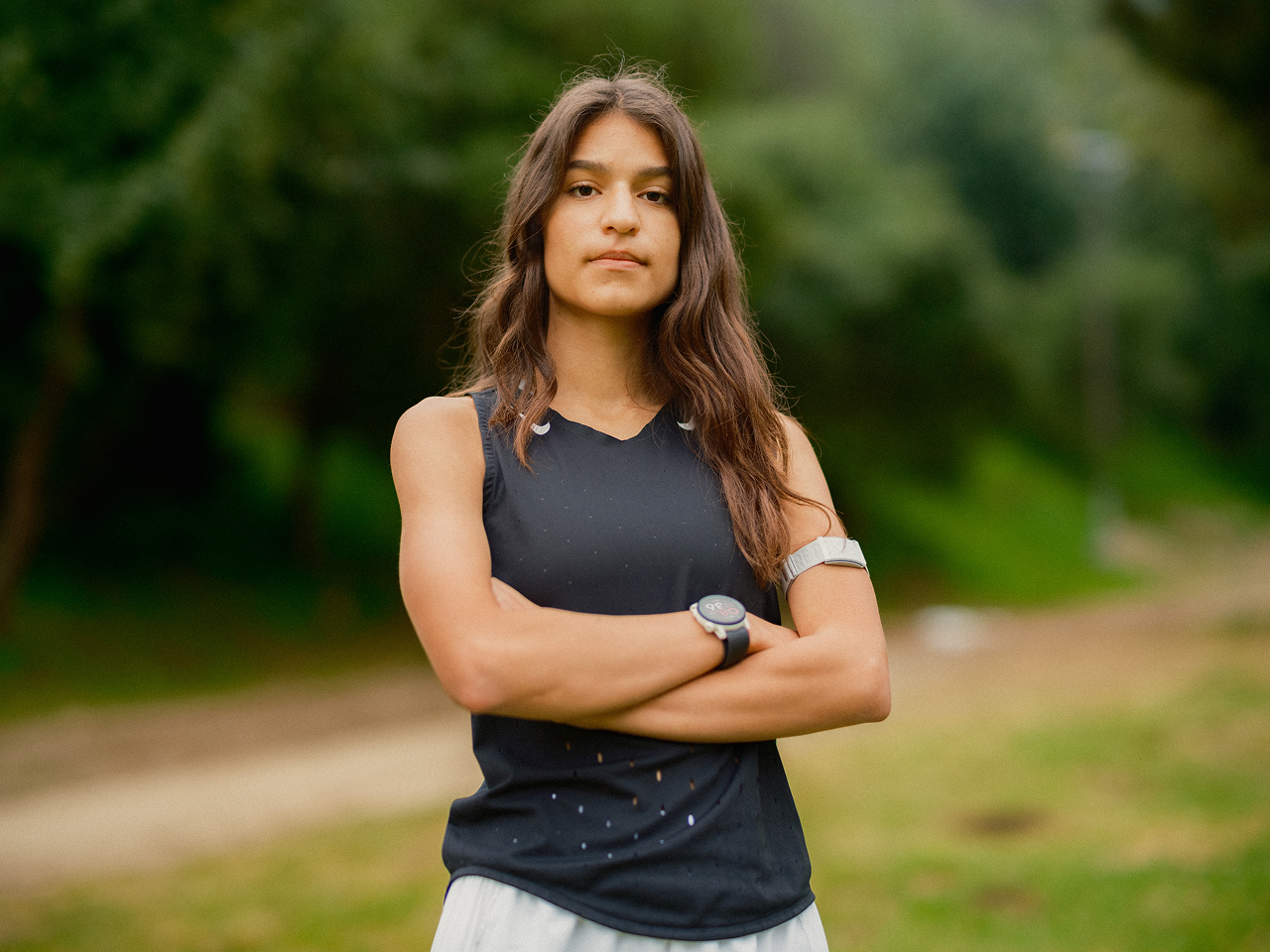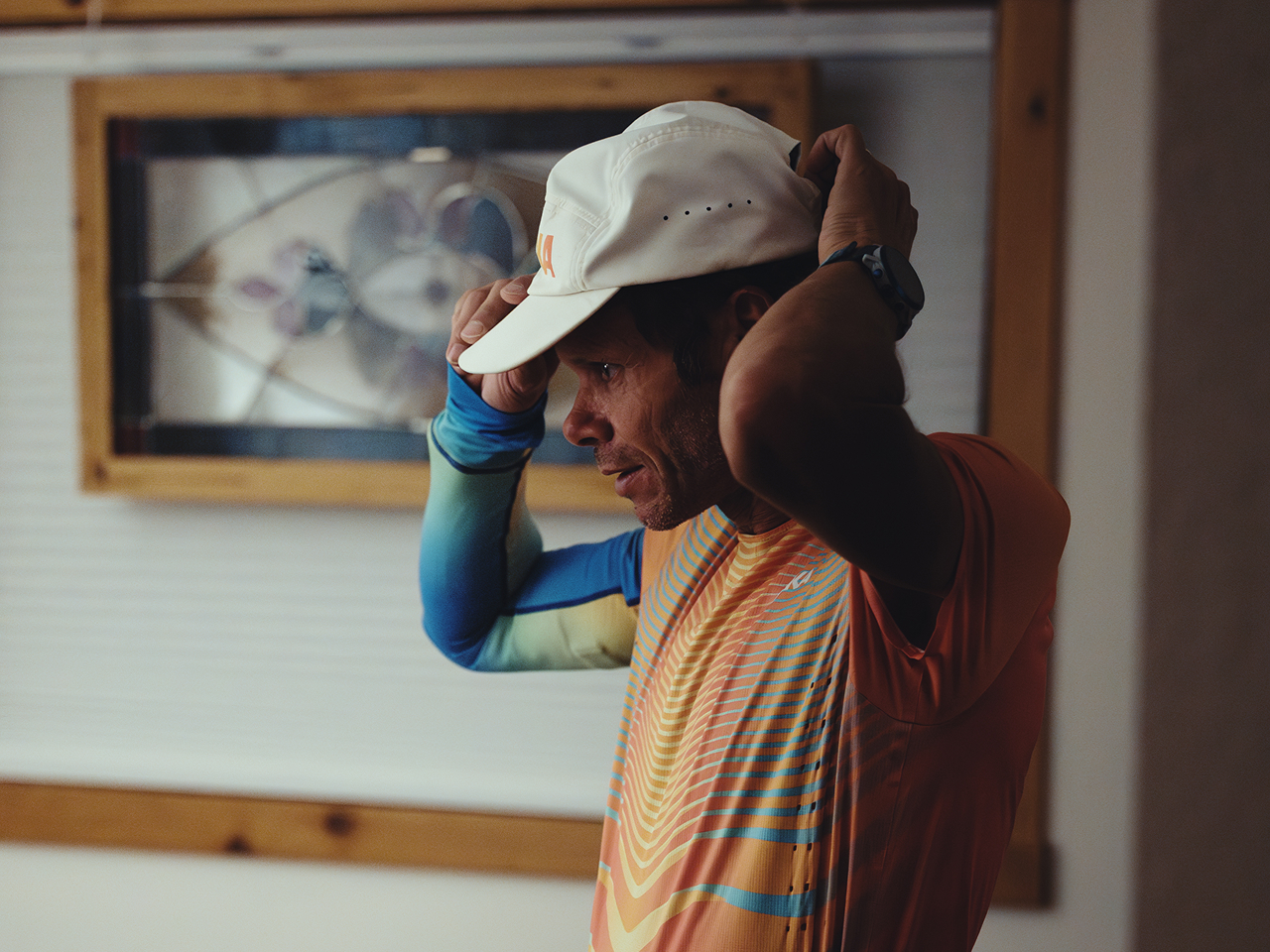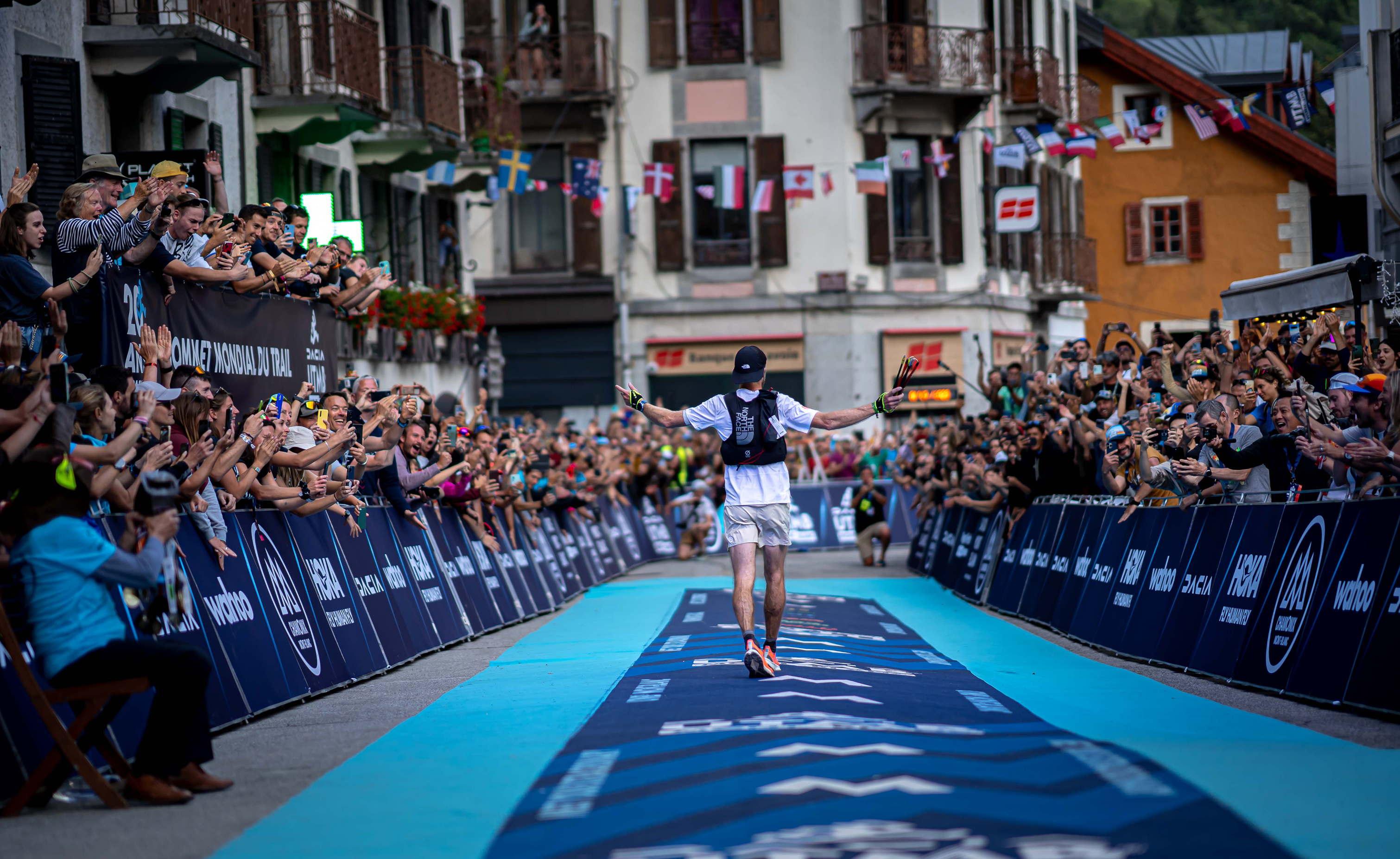A Journey Of A Lifetime
Liv Sansoz is a lifelong endurance athlete and mountaineer who currently resides in Chamonix, France. There, she is a mountain guide, helping locals and visitors experience the beauty of the Alps via summitting mountains, ice climbing, and skiing. As a two-time World Champion in Sport Climbing and three-time World Cup winner, Liv is an expert professional rock climber who has mastered many disciplines, including ice climbing, lead climbing, and bouldering. From 2017 to 2018, Liv famously climbed all eighty-two 4000m peaks in the Alps using no lifts, on foot using a paraglider. However, Liv had never climbed as high as 8000m, which became the utmost challenge she dreamed about for years, until now.
Sitting at 8,611 meters above sea level (28,251 feet), K2 resides in the Karakoram range of Pakistan and is the second-highest summit in the world next to Mount Everest. It has been deemed one of the deadliest mountains, with 96 deaths occurring over an estimated 378 summits as of 2023 (that's less than the number of people who has been to space). It is a summit that only the best and most experienced climbers in the world should ever attempt.
“I told myself if I was going to climb one 8000m peak, it would be K2. It's the most beautiful one, and a very steep mountain,” said Liv. For Liv and her husband Zeb Roche, who completed the ascent with her, K2 carried a lot of significance, as it was an extreme challenge about facing discomfort. According to Liv, it is the hardest 8000m summit to climb because of how steep it is. The weather is constantly changing at this altitude, it is completely remote, and you have to stay for 2 months at base camp on a morraine before you can even attempt the climb. Additionally, there are limited resources. “There is no helicopter, no rescue. It makes everything a little bit harder,” she explains.
Back in 2021, they made a plan that they would summit together and descend by flying off the mountain via paraglide. For Zeb, who had submitted Everest twice and flew down the second time in 2001, he knew it was doable. It would be the first time anyone attempted to fly down from K2 in tandem, and the couple was motivated by the challenge. A few other attempts to fly down had been done before, but they were unsuccessful.
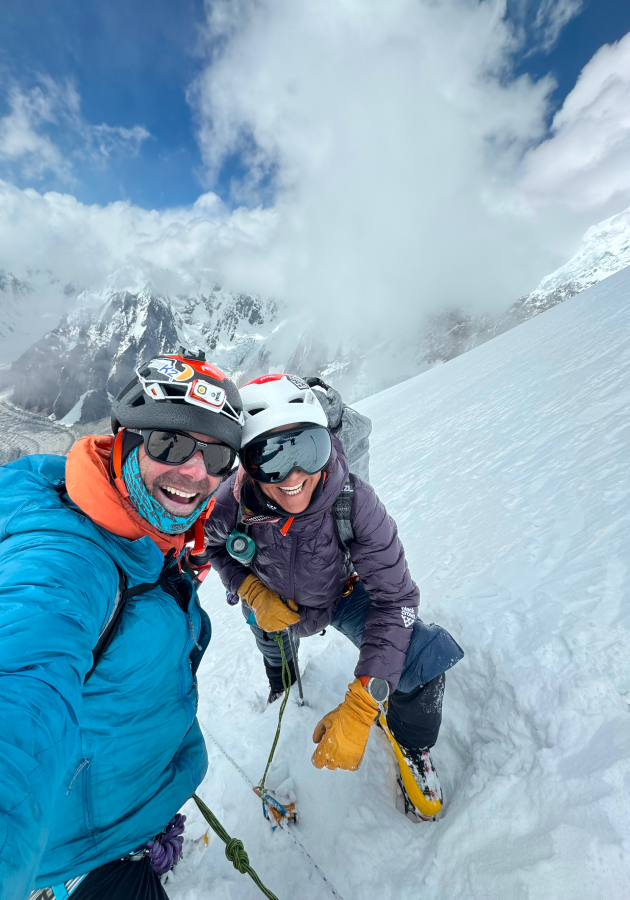
Liv and her husband, Zeb Roche getting some acclimatization done on Broad Peak.
Training for K2: How Liv Prepared Her Body to Summit 8,000 Meters
Building Endurance, The Alpinist Way
During the winter months leading up to K2, Liv did a lot of SkiMo (ski mountaineering), 25 days per month for a minimum of four hours a day. Similar to Kilian Jornet who spends 5 months out of the year cross-training with SkiMo and low impact exercise, Liv uses SkiMo as a way to build aerobic capacity with a lot of volume, while recovering faster. It was also important for Liv to log plenty of elevation each day. She would spend hours in the surrounding mountains by Chamonix to help her body adapt to higher elevation.
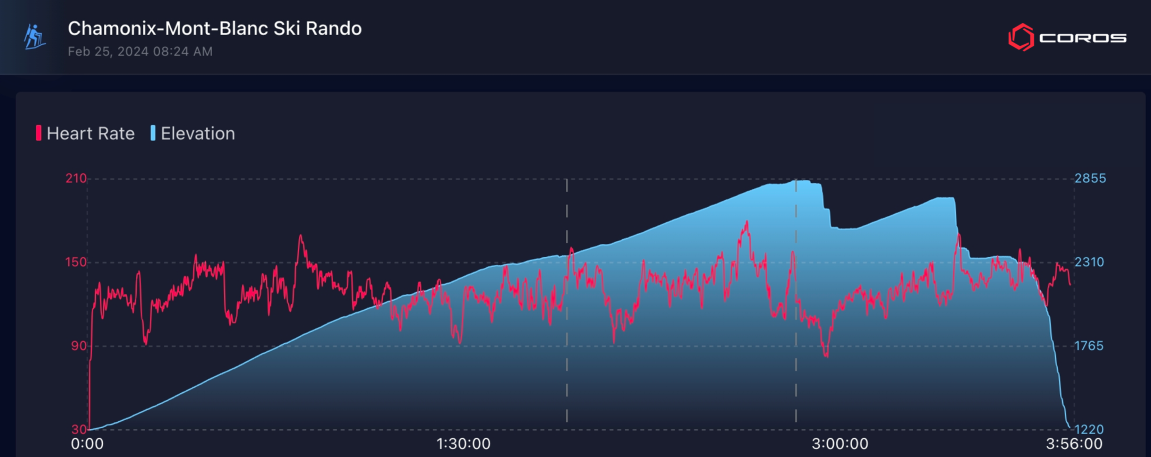
To build an aerobic base, Liv logged hours of cross-training, including SkiMo.
Once the snow started clearing and the trails were accessible in April, Liv incorporated more intense workouts to her regimen. She incorporated interval training to gain speed on top of her general fitness, but this wasn't your typical intervals on the roads or track. As an alpinist, Liv did intervals on the steep, ski jump stairs in Chamonix, and on surrounding slopes near her house. She also trained carrying her supplies (23kg/ 50lbs) up very steep climbs, logging 1000m per session. She describes these steep climbs as the hardest part of training.

Liv incorporated interval training on local ski jump stairs in Chamonix to build her endurance.
The Art of Acclimatization
In June of 2024, Liv and her husband began their K2 expedition. In total, the journey took 2 months, but most of that time was spent acclimating to the extremely high altitude, practicing summiting, and waiting for the right weather conditions. The actual climb to K2 took three days after weeks of preparation and identifying the perfect weather from July 26-28 to make the trip.
Below is a timeline that breaks down the full journey and how much time they needed to acclimate.
| Timeline | Travel and Elevation |
| Weeks 1-2 | Traveled 100km to reach the first base camp at 5000m elevation. |
| Weeks 2-6 | Spent 3-4 weeks acclimatizing and bringing gear to the altitude camps (Camp 2, 6660m). |
| Day 1 of K2 Climb Friday, July 26th | Climbed from 5000m to 6600m. |
| Day 2 of K2 Climb Saturday, July 27th | Climbed from 6600m to 7400m |
| Day 3 of K2 Climb Sunday, July 28th | Summited at 8611m. |
“The principal of acclimatization is to go 500m at a time,” explains Liv, once you are higher up. “You don’t want to do 1500m the first day, otherwise it will take you 10 days to recover.” Additionally, the higher you go, the more intense the lack of oxygen becomes, as the proportions do not operate on a linear curve.
During the 3-week period at 5000m, Liv and her team went up and down, up and down, over and over again in small increments to get used to elevation. They would climb 500m, sleep at higher altitudes to get used to the lack of oxygen, then come down and do it all over again.
“The highest we could sleep was at 6600m, because the weather was really bad this year. We wanted to do one night at 7000m, but it was not possible due to the severe wind and possible avalanches.”
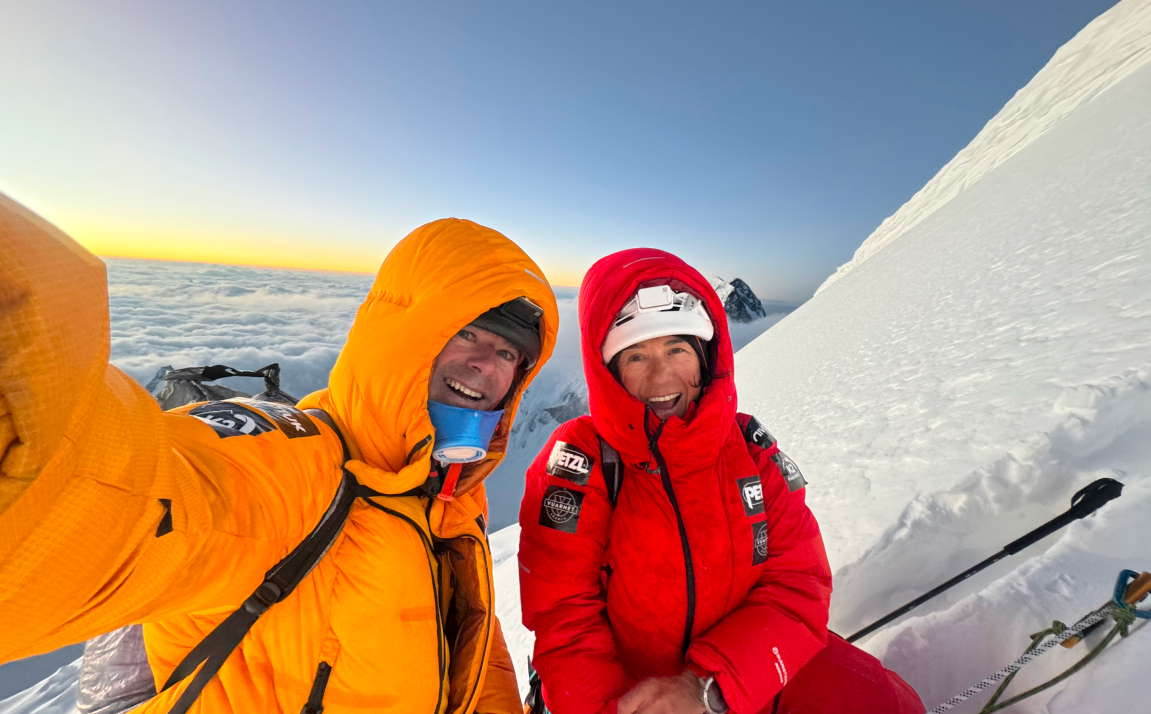
Liv and her husband Zeb on their way to K2 summit at sunrise
Safety First: Monitoring Vitals Towards The Summit
There is a myriad of safety concerns climbers must prepare for when summiting extremely high peaks. Packing enough food, but not so much that it slows you down. Preparing for bad weather and extreme cold. Basic survival skills that the average person doesn't need to worry about. However, one of the most important safety factors to consider is preparing for the severe lack of oxygen
When you climb without oxygen, there is a high risk for hypoxia, a condition that results in confusion, difficulty breathing, and rapid heart rate. This can lead to death. “Every 100m you go, it gets harder,” Liv explained. “I was looking a lot at my COROS watch, mostly for the altitude and the time. Because at 5pm if we hadn't reached the summit yet, we had to go back down to our previous camp.”
Initially, Liv purchased her COROS VERTIX 2 because she'd heard how good the battery life was. She knew she needed a watch like this for a trip where she’d be packing as light as possible, so chargers and devices were left back at base camp. Throughout the 2-month expedition, Liv, who is not a sponsored COROS athlete, only charged the watch once at base camp, and didn't need to bring any chargers during the actual K2 summit.
During the ascent, she relied on the watch to keep track of every minute and the increments of elevation. “The last 150 meters took us 3 hours. We gained 50m in an hour. It's how bad the lack of oxygen is on your body. I'm a mountain guide who trained specifically 6 days a week to be ready, and even with that, the last 150 meters were extremely slow,” said Liv.
“I'm watching my heart rate and doing the math on how fast we're going. I was always looking at my watch because in an oxygen-deprived state, you have a lot of brain fog and distortion. The time is different. The first time we stopped to rest for 5 minutes, I looked down at my watch and 40 minutes had gone by. When I realized that, I got very scared because you have no ideas where the time goes.”
Liv explained the serious danger of losing track of time during these summits. “We know a lot of people who say ‘let’s rest for 5 minutes’ and they don’t wake up. You’re so tired, your body wants to sleep. I had to look at my watch constantly to be sure we were not losing time and to know exactly how much we rested.” During these moments, Liv and Zeb were constantly communicating, checking in on each other to keep their minds active and their bodies moving, while keeping track of basic metrics such as heart rate, elevation, time of day, and climate changes via COROS.
Making History By Flying Off The Mountain
On July 28, 2024, Liv and her husband became the first people to descend K2 by flying off the mountain via paraglide. As scary as that sounds, Liv explains that it's actually the safest option (as long as you know what you're doing). It only took them 35 minutes to descend, versus the two days it would have taken on foot. On foot, you're dealing with avalanches, rocks, crevasses, and seracs that pose danger. “If you know how to fly and you have good conditions that day, it's much safer and less tiring. There were no clouds. We could see everything and enjoy the view!”
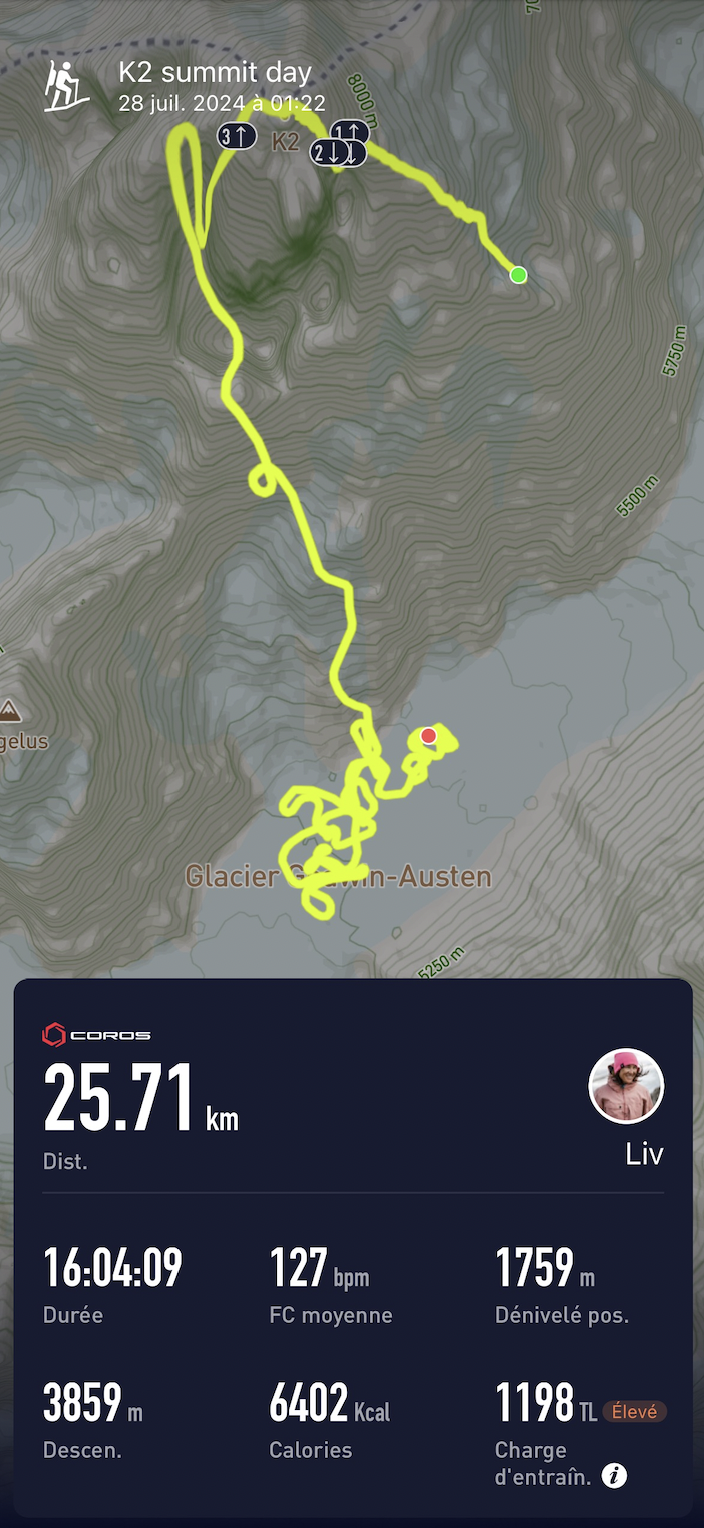
Day 3 of Liv's K2 summit.
To fly off K2 using a paraglide, it takes quite the lesson in physics. Because the air is much thinner at 8000m, you actually need more wind to throttle you forward, or you need a longer running start. Liv had done plenty of jumps of Mont Blanc back home (4805m), but at a higher altitude, the behavior of a paraglide wing is more delicate, as the air is not as dense and as easy to navigate. Additionally, flying tandem is more technical because the wing is bigger, and the lines are longer. Every gesture or action you take needs to be instinctive. "You can't think when you're in this situation," said Liv.
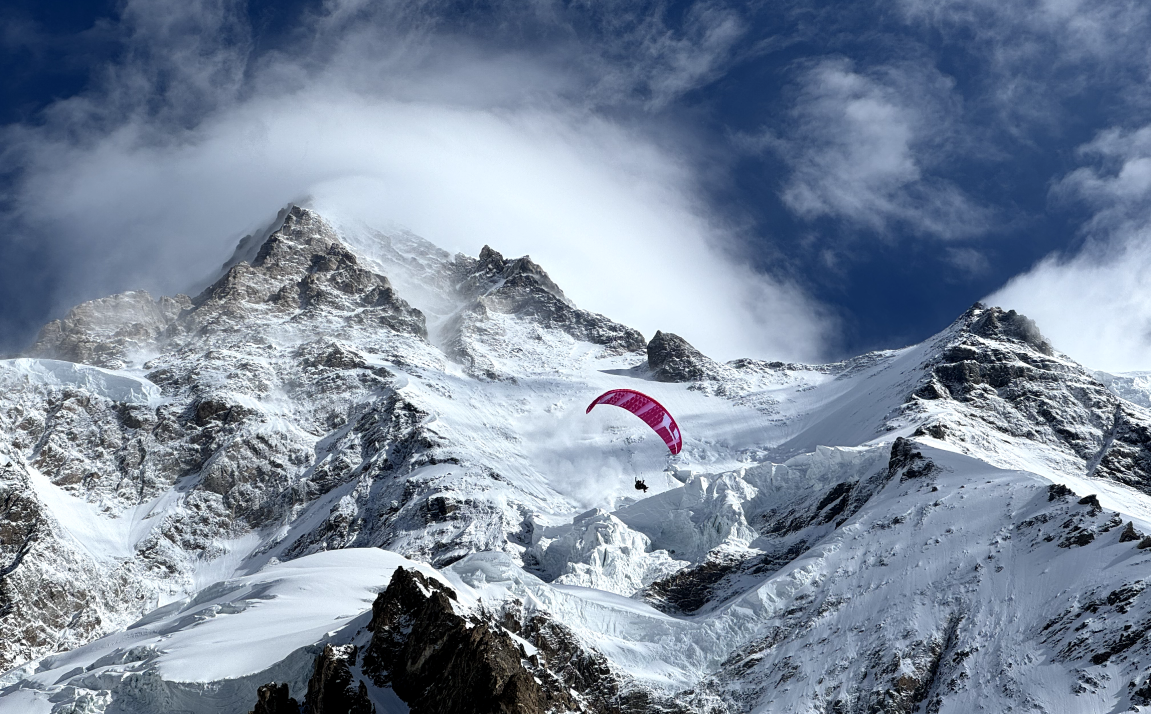
Liv and Zeb flew off K2 using a custom-made tandem paraglide. The conditions were perfect that day with clear skies and packed snow to run on during takeoff.
"When we arrived on the summit of K2, it was really calm. We realized we would have to run. We were tired and worried it would be hard, but we got lucky as the snow was hard and not a deep powder. Otherwise, it would have been impossible to run and take off," Liv explained. "It took us 10 steps before we felt the wing carry our weight...then we were flying."
The paraglide wing Liv and her husband used was a prototype specifically designed for them and their weight. To minimize as much weight as possible, they hired someone to carry down various gear from the last camp where they slept, including things like their tent, sleeping bags, mattress, stove, and extra food they didn't need on their last day to the summit.
Liv's K2 Summit Goes Down in the Books
The most memorable moment for Liv? Simply realizing they had done it. "When we landed and realized 'We did it! We just climbed K2 without oxygen and flew off it!'" Liv is the second French woman to summit K2 without oxygen. She estimates about 8-10 women have climbed K2 without oxygen (not all have been recorded since women have been attempting this since 1986).

Liv and Zeb celebrate with a chocolate cake after completing their summit and descent from K2
When asked if she would ever do it again, Liv wasn't quite sure. She would love to do another 8000m peak and fly down with a paraglider, but K2 was probably a one and done situation, and she's proud of that.
COROS wishes a huge congratulations to Liv and her husband, who have pushed the limits of what’s possible in the mountains. You can follow Liv’s adventures on Instagram @livsansoz.

/filters:quality(90)/fit-in/970x750/coros-web-faq/upload/images/0262cbf0b39a19f552bc8b70e4c0a915.png)
